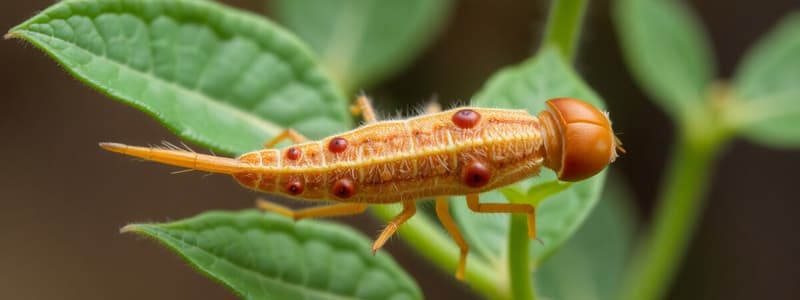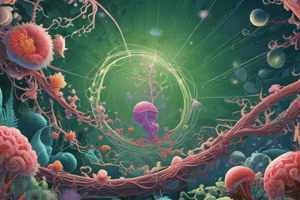Podcast
Questions and Answers
What is a key characteristic that distinguishes living organisms from non-living things?
What is a key characteristic that distinguishes living organisms from non-living things?
- Absence of reproduction
- Lack of energy usage
- Inability to grow
- Cellular organization (correct)
Which level is NOT part of the biological classification hierarchy?
Which level is NOT part of the biological classification hierarchy?
- Kingdom
- Phylum
- Population (correct)
- Species
Which type of cell contains a nucleus and membrane-bound organelles?
Which type of cell contains a nucleus and membrane-bound organelles?
- Prokaryotic cells
- Virus cells
- Eukaryotic cells (correct)
- Bacterial cells
What role do genes play in living organisms?
What role do genes play in living organisms?
Which characteristic of living organisms involves changing to better suit the environment?
Which characteristic of living organisms involves changing to better suit the environment?
Flashcards
What is Biology?
What is Biology?
The study of living organisms, their structure, function, growth, evolution, and interactions with their environment.
What is a cell?
What is a cell?
The smallest unit of life that can perform all life processes, such as metabolism and reproduction.
What is Evolution?
What is Evolution?
The process by which organisms change over time in response to their environment, leading to the diversity of life we see today.
What is Homeostasis?
What is Homeostasis?
Signup and view all the flashcards
What is Genetics?
What is Genetics?
Signup and view all the flashcards
Study Notes
Introduction to Biology
- Biology is the scientific study of life.
- It covers a vast range of topics, from the molecular to the ecosystem level.
- Core biological concepts include evolution, genetics, ecology, and physiology.
- Biology aims to understand the structure, function, and interactions of living organisms.
- It uses observation and experimentation to develop and test hypotheses, ultimately building biological theories.
Characteristics of Living Organisms
- Living things exhibit key characteristics distinguishing them from non-living matter:
- Cellular organization: All living things are composed of cells.
- Metabolism: Organisms use energy for growth, maintenance, and reproduction.
- Responsiveness: Organisms react to internal and external stimuli.
- Homeostasis: Organisms maintain stable internal conditions.
- Growth and development: Organisms increase in size and complexity over time.
- Reproduction: Organisms produce new organisms of the same kind.
- Adaptation: Organisms evolve to better suit their environments.
Biological Classification
- Biological classification categorizes living organisms into hierarchical groups based on shared characteristics.
- The system uses levels: domain, kingdom, phylum, class, order, family, genus, and species.
- Placement reflects evolutionary relationships.
- Modern classification heavily relies on evolutionary relationships, using genetic analysis and anatomical structure comparisons.
Cell Biology
- Cells are the basic units of life.
- Prokaryotic cells lack a nucleus and membrane-bound organelles.
- Eukaryotic cells have a nucleus and membrane-bound organelles (like mitochondria and chloroplasts).
- Cells perform vital functions including metabolism, reproduction, and stimulus response.
- Cell membranes control the passage of molecules.
Genetics
- Genetics studies heredity and variations in living organisms.
- Genes contain hereditary information encoded in DNA.
- DNA sequences direct protein synthesis, producing diverse proteins.
- DNA mutations cause variations within and between species.
- Mendelian genetics describes inheritance patterns of dominant and recessive traits.
- Modern genetics includes understanding DNA structure/function, gene expression, and genetic engineering.
Evolution
- Evolution describes changes in heritable traits within biological populations over generations.
- Natural selection favors advantageous traits, increasing their prevalence.
- Genetic variation is essential for evolution.
- Evolution explains Earth's diverse life forms and their relationships.
- Evidence for evolution comes from fossil records, comparative anatomy, and molecular biology.
Ecology
- Ecology studies the interactions between organisms and their environment.
- It examines organism distribution, abundance, influential factors, and species relationships.
- Ecosystems encompass all biotic and abiotic factors.
- Ecological principles underpin conservation and environmental studies.
- Key ecological concepts include population dynamics, community interactions, and ecosystem processes.
Physiology
- Physiology studies how living organisms function.
- It examines physical and chemical processes from cellular to organism levels.
- Physiological processes maintain homeostasis, crucial for survival.
- Examples include respiration, digestion, thermoregulation, and reproduction.
- Physiology encompasses human, plant, and animal physiology.
Studying That Suits You
Use AI to generate personalized quizzes and flashcards to suit your learning preferences.



